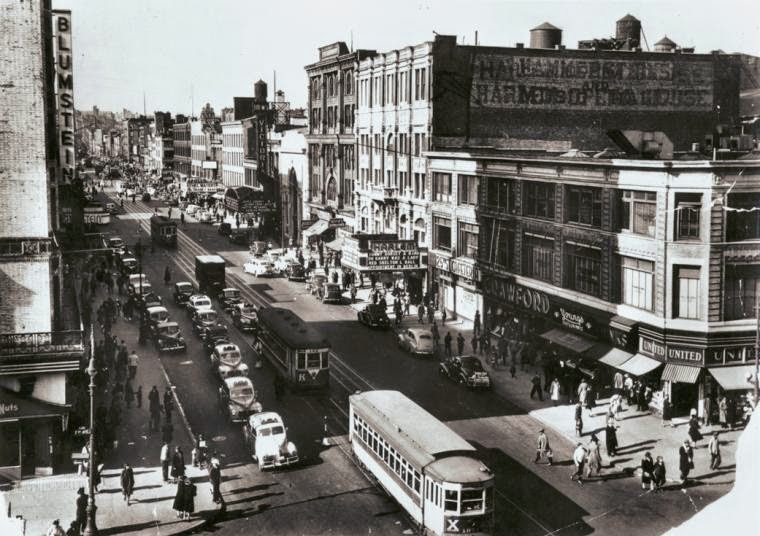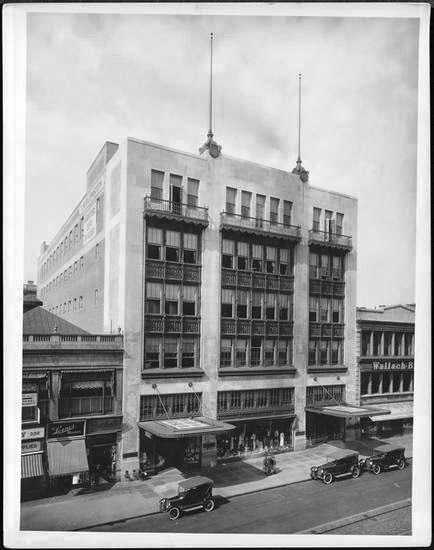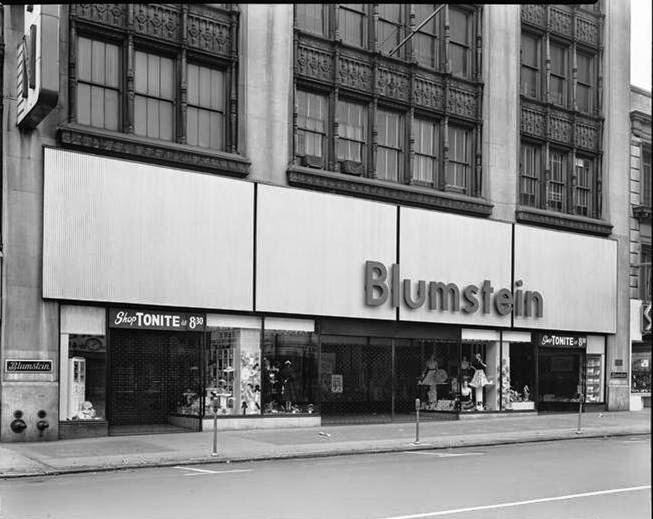 |
| photo by Nicolas Lemery Nantel / salokin.com |
When Louis Blumstein arrived in New York in 1885, the
mansion of Dr. John Ferdinand stood in the Harlem area that would become West
125th Street. Before the end
of the century the neighborhood would become a high-end suburb and the
doctor’s handsome home would be gone.
Blumstein established a dry goods store in 1886. When he
moved northward to West 125th Street between Seventh and Eighth Avenues two
years later, the street already bustled with shoppers.
Blumstein’s Department Store was soon a fixture and was run as a family
business. According to Jonathan Gill in
his book Harlem, “At a time when
signs reading Keine Juden, und Keine
Hunde (‘No Jews, and No Dogs’) could be seen in shop windows, Blumstein’s
became a favorite of uptown’s German Jews.”
The management methods of the sometimes stern German Blumsteins,
however, was not always appreciated. Carolyn
Stock worked in the store in March 1900 when Benjamin Blumstein asked her to
show him a box of handkerchiefs. By
mistake she pulled down the wrong box.
Blumstein’s reaction was, perhaps, excessive.
Carolyn charged “he grasped the box and threw it at her,
striking her on the side, and that later he threatened to kill her with a
hammer, and struck her with his fist and threw her against a wall,” reported
The New York Times. She complained that
the attacked resulted “in nervous prostration.”
Carolyn Stock sued Benjamin Blumstein personally for $2,000
damages. The retailer’s lawyer insisted that
“the handkerchief box fell on the floor, and that the proprietor walked away
without doing anything.” The jury
deliberated for ten minutes and granted the salesgirl’s demands—about $54,000
today.
Blumstein’s was a rather upscale department store, offering
Easter Dresses in 1911 for $18.50; more in the neighborhood of $450 today. But Harlem was changing. More and more black residents moved into
Harlem hoping to escape the discriminatory practices of downtown
landlords. The Blumstein brothers
resisted the change and it would later cause them problems.
On Sunday, January 25, 1920 Louis Blumstein died at the age
of 56. The family mourned, then got on
with enlarging the business. On July 3,
1921 The New York Times reported that Blumstein’s would begin tearing down five
old buildings that week. The old
two-story department store would go, as would the buildings facing 124th
Street. “Plans were prepared several
months ago by the architects, Robert D. Kohn and Charles Butler, for an
eight-story building to cover the entire site,” said the newspaper.
Placing the cost at $1.25 million, The Times said “It will
be the most ambitious structure erected in the Harlem area for many years. In order to avoid disruption of business, the
124th Street section was constructed first. Then the store was moved to that area and the
original store demolished and rebuilt.
“Among the features of the new store will be high ceilings
and a maximum of show window space of the type known as ‘island windows,’ which
are much more common in the Middle West and on the Pacific Coast than in New
York,” said the newspaper. “A complete
fresh air supply and exhaust system is designed to include air washers and
cooling apparatus.”
Among the conveniences for shoppers were five passenger
elevators and a cafeteria in the basement.
On the top floor were “rest and recreation rooms for employes.” The building was completed in 1923—an unexpected
combination of the arriving Art Deco movement and the quickly-receding Art
Nouveau. Copper was more important than
limestone in the architects’ novel design.
Above the three sets of grouped openings were unusual and eye-catching
copper awnings.
 |
| Exquisitely worked copper, unnoticed from street level, and innovative awnings distinguished the design -- photo by Nicolas Lemery Nantel / salokin.com |
Before the decade was up, black shoppers at Blumstein’s
outnumbered whites. But the employees
were, with the exception of menial labor, all white. It was a situation that did not go unnoticed
by residents increasingly vocal about their civil rights.
In 1934 The Citizens’ League For Fair Play plastered the
streets with fliers that read “Refuse to Trade with L. M. Blumstein 230 West
125th Street” and “This firm, acknowledging its large proportion of
Negro business, has refused to employ Negro Clerks. Stay out of Blumstein’s! Refuse to buy there!”
The League’s economic boycott was supported by more than 50
churches and groups. Among those
churches was the Abyssinian Baptist Church pastored by both Adam Clayton Powell,
Sr. and Jr. The boycott—the theme of
which was “Don’t Buy Where You Can’t Work”—was successful. Not only did the Blumsteins change their
hiring practices; their department store was the first to use black mannequins
and—no doubt a shock to some white shoppers—a black Santa Claus at Christmas
time.
In 1937 20-year old Irving Barr had been working in the
store as a sign painter and handyman for several years. Surrounded by jewelry and other expensive
items, the low-paid Barr hatched a plan.
On May 11 he hid in the store at closing time, waiting until everyone
was gone. He then stole two suitcases
from the store’s stock and filled them with fountain pens, watches and other
easily transportable costly items.
Suddenly Barr was discovered by the watchman, Joseph Geiger,
described by The New York Times as “a frail 61-year old man.” Knowing that Geiger recognized him, Barr
panicked. He hit the old man repeatedly
with a hammer.
Barr rushed to the roof of Blumstein’s and tossed the two
suitcases to the roof of a nearby apartment building. Police said that he then “descended to the
engine room and hit Geiger again.” After
what The Times called “intensive detective work,” Barr was arrested and charged
with homicide.
 |
| West 125th Street in 1943 bustled with taxicabs, streetcars and nicely-dressed shoppers. Blumstein's can be seen at the far left -- from the collection of the New York Public Library |
The store that had unintentionally been a flash point in the
early civil rights movement welcomed Martin Luther King to the store for a book
signing on September 20, 1958. King sat
behind a table autographing copies of his Stride
Toward Freedom when Mrs. I. W. Curry approached. The woman groped in her purse and pulled out
a sharp stiletto-like letter opener which she plunged into the civil rights
leader’s chest.
An elderly customer, Mrs. James Watson moved to remove the
weapon; but another woman cautioned against it.
Dr. King lay on the floor assuring the gathering crowd “That’s all
right! That’s all right. Everything is
going to be all right!”
When the ambulance arrived a few minutes later, the weapon
was still protruding from King’s chest.
The customer’s prudent action, or lack of action, no doubt resulted in his
survival. King was rushed to Harlem
Hospital where the wound was treated.
Mrs. Curry’s letter opener had grazed the aorta without piercing it.
The succession of Blumsteins at the helm of the department
store would continue for years. On
August 29, 1960 William Blumstein died, and Jack Blumstein took over as
President. By now the store that had
once refused to accept change was an active participant in the community. In June 1965 the National Council of Negro
Women sponsored a showing of paintings by black artists here. Five years later when Abraham & Straus
and Macy’s department stores announced with self-applauding fanfare that they
would include black Santas on their Christmas floors, The New York Times
pointed out that “Blumstein Department Store at 230 West 125th
Street in Harlem, however, has had a black Santa Claus for more than 20 years.”
By now the Blumstein building was suffering from old age. When The Times described the proposed
structure in 1921 it made note of the basement.
“A staircase immediately adjoining the entrances will lead to the
basement store, which it is planned to make the best ventilated basement in the
city.”
Now, in 1971 the pet shop was in the basement and New York
Magazine’s description was less glowing, saying it was located “down two
slightly dingy flights of steps.” Nevertheless,
the store offered an amazing selection of animals, many of which would be
illegal today.
“The pet shop is a squawky display of exotic plumage of some
50 varieties of birds,” said the magazine.
“The shop also shelters a pair of Capuchin (organ grinder) monkeys, many
tanks of exotic fish and an assortment of fresh aquarium plants.”
Five years after the article was printed, the Blumstein
family sold the building. Before long a
variety of small businesses filled the now-divided floors where women had shopped
for Easter dresses and, later, civil rights history played out. In 2002 the
last president of Blumstein’s Department Store, Kyver Blumstein, died at the
age of 95.
Today Touro College has taken over much of the building as
its college of medicine and college of pharmacy. Distracting plastic retail signs
plaster the lower levels so that only by glancing upward can a passerby
appreciate the surviving remnant of an important part in Harlem’s development
and the Civil Rights movement in America.



.png)

I remember going there with my mother.
ReplyDeleteIt was a beautiful experience.
It gave a little girl from Harlem an experience of luxury.
Every floor had it's specialty.
I went there as a kid with my mother too. It was the first time I'd ever seen a black Santa
DeleteIt was Harlem’s 34th. St having Macy’s uptown. It was nice and I even got to meet a Black Santa which is a whole mother story.
ReplyDeleteI grew up just a few blocks away from Blumstein's, on Convent Avenue 128th Street in the 1970's. Blumstein's, Woolworth's and Johnson's Diner (on St. Nicholas Avenue) was always one of our (my belated beautiful Mom, and my brothers) stops throughout the week and especially on Saturdays after watching "The Soul Train". Harlem has since changed dramatically, but it's nice to see that some of its history is still being told and embraced. God Bless.
ReplyDeleteMy mother would send me to Blumstein's to buy hosiery for her back in the days of "seams" and "garter belts". And, I remember my sister and I being fitted for Buster Brown Mary Jane patent leather shoes and navy blue coats for Easter. That winter, along with a new coat we received bunny fur hats & matching hand muffs for Christmas. I'm one of the first of the Baby Boomers so you know how long ago that happened. We lived on 123rd St and looked through at the back of Blumstein's from the side of our building. There were no buildings blocking a clear site line even though we were a full block away. We shopped at Blumstein's or on Delancey St where we did not have to deal with negative assumptions and behaviors from sales personnel.
ReplyDelete